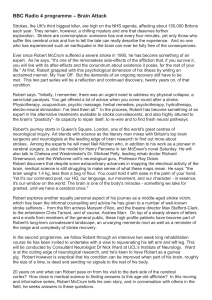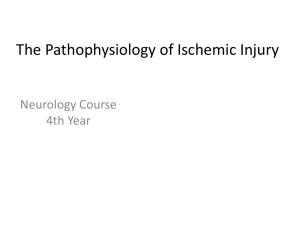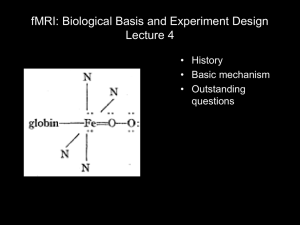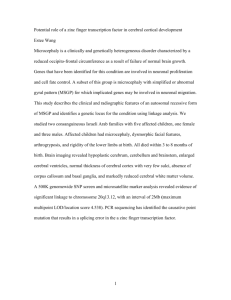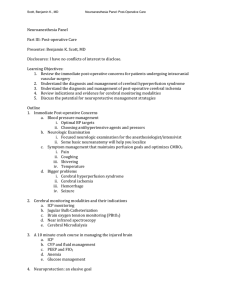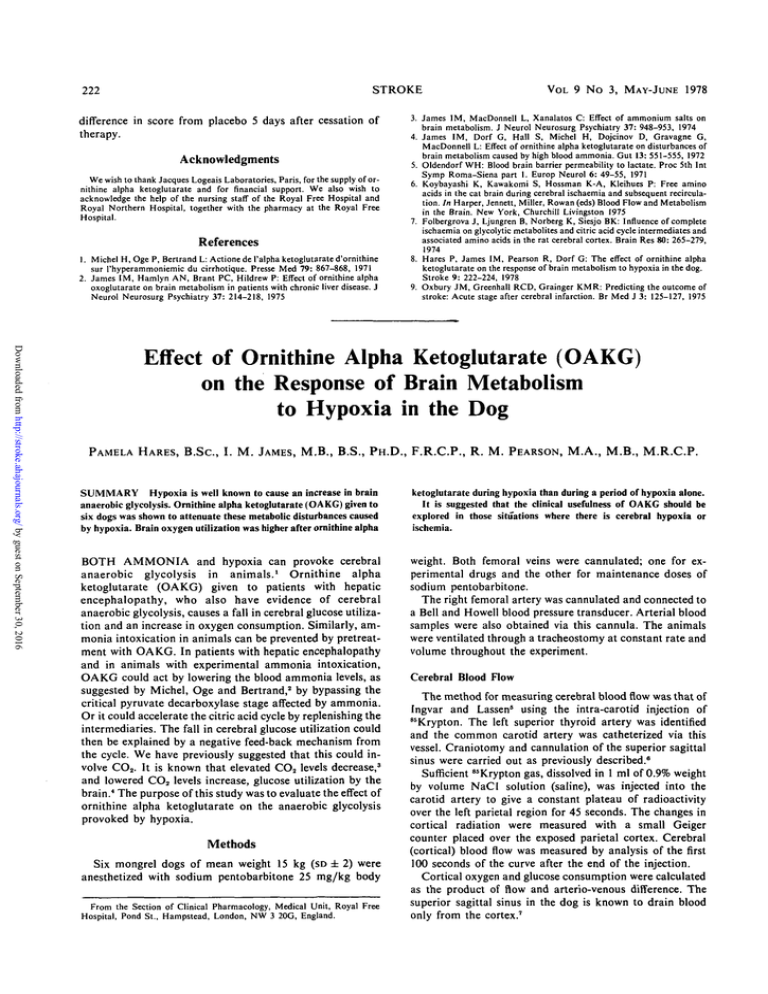
STROKE
222
difference in score from placebo 5 days after cessation of
therapy.
Acknowledgments
We wish to thank Jacques Logeais Laboratories, Paris, for the supply of ornithine alpha ketoglutarate and for financial support. We also wish to
acknowledge the help of the nursing staff of the Royal Free Hospital and
Royal Northern Hospital, together with the pharmacy at the Royal Free
Hospital.
References
1. Michel H, Oge P, Bertrand L: Actionede Palpha ketoglutarate d'ornithine
sur rhyperammoniemic du cirrhotique. Presse Med 79: 867-868, 1971
2. James IM, Hamlyn AN, Brant PC, Hildrew P: Effect of ornithine alpha
oxoglutarate on brain metabolism in patients with chronic liver disease. J
Neurol Neurosurg Psychiatry 37: 214-218, 1975
VOL 9 No 3, MAY-JUNE 1978
3. James IM, MacDonnell L, Xanalatos C: Effect of ammonium salts on
brain metabolism. J Neurol Neurosurg Psychiatry 37: 948-953, 1974
4. James IM, Dorf G, Hall S, Michel H, Dojcinov D, Gravagne G,
MacDonnell L: Effect of ornithine alpha ketoglutarate on disturbances of
brain metabolism caused by high blood ammonia. Gut 13: 551-555, 1972
5. Oldendorf WH: Blood brain barrier permeability to lactate. Proc 5th Int
Symp Roma-Siena part 1. Europ Neurol 6: 49-55, 1971
6. Koybayashi K, Kawakomi S, Hossman K-A, Kleihues P: Free amino
acids in the cat brain during cerebral ischaemia and subsequent recirculation. In Harper, Jennett, Miller, Rowan (eds) Blood Flow and Metabolism
in the Brain. New York, Churchill Livingston 1975
7. Folbergrova J, Ljungren B, Norberg K, Siesjo BK: Influence of complete
ischaemia on glycolytic metabolites and citric acid cycle intermediates and
associated amino acids in the rat cerebral cortex. Brain Res 80: 265-279,
1974
8. Hares P, James IM, Pearson R, Dorf G: The effect of ornithine alpha
ketoglutarate on the response of brain metabolism to hypoxia in the dog.
Stroke 9: 222-224, 1978
9. Oxbury JM, Greenhall RCD, Grainger KMR: Predicting the outcome of
stroke: Acute stage after cerebral infarction. Br Med J 3: 125-127, 1975
Downloaded from http://stroke.ahajournals.org/ by guest on September 30, 2016
Effect of Ornithine Alpha Ketoglutarate (OAKG)
on the Response of Brain Metabolism
to Hypoxia in the Dog
PAMELA HARES, B . S C ,
I. M. JAMES, M.B., B.S., PH.D., F.R.C.P., R. M.
PEARSON,
M.A., M.B., M.R.C.P.
SUMMARY Hypoxia is well known to cause an increase in brain
anaerobic glycolysis. Ornithine alpha ketoglutarate (OAKG) given to
six dogs was shown to attenuate these metabolic disturbances caused
by hypoxia. Brain oxygen utilization was higher after ornithine alpha
ketoglutarate during hypoxia than during a period of hypoxia alone.
It is suggested that the clinical usefulness of OAKG should be
explored in those situations where there is cerebral hypoxia or
ischemia.
BOTH AMMONIA and hypoxia can provoke cerebral
anaerobic glycolysis in animals.1 Ornithine alpha
ketoglutarate (OAKG) given to patients with hepatic
encephalopathy, who also have evidence of cerebral
anaerobic glycolysis, causes a fall in cerebral glucose utilization and an increase in oxygen consumption. Similarly, ammonia intoxication in animals can be prevented by pretreatment with OAKG. In patients with hepatic encephalopathy
and in animals with experimental ammonia intoxication,
OAKG could act by lowering the blood ammonia levels, as
suggested by Michel, Oge and Bertrand,2 by bypassing the
critical pyruvate decarboxylase stage affected by ammonia.
Or it could accelerate the citric acid cycle by replenishing the
intermediaries. The fall in cerebral glucose utilization could
then be explained by a negative feed-back mechanism from
the cycle. We have previously suggested that this could involve CO2. It is known that elevated CO2 levels decrease,3
and lowered CO2 levels increase, glucose utilization by the
brain.4 The purpose of this study was to evaluate the effect of
ornithine alpha ketoglutarate on the anaerobic glycolysis
provoked by hypoxia.
weight. Both femoral veins were cannulated; one for experimental drugs and the other for maintenance doses of
sodium pentobarbitone.
The right femoral artery was cannulated and connected to
a Bell and Howell blood pressure transducer. Arterial blood
samples were also obtained via this cannula. The animals
were ventilated through a tracheostomy at constant rate and
volume throughout the experiment.
Methods
Six mongrel dogs of mean weight 15 kg (SD ± 2) were
anesthetized with sodium pentobarbitone 25 mg/kg body
From the Section of Clinical Pharmacology, Medical Unit, Royal Free
Hospital, Pond St., Hampstead, London, NW 3 20G, England.
Cerebral Blood Flow
The method for measuring cerebral bloodflowwas that of
Ingvar and Lassen6 using the intra-carotid injection of
85
Krypton. The left superior thyroid artery was identified
and the common carotid artery was catheterized via this
vessel. Craniotomy and cannulation of the superior sagittal
sinus were carried out as previously described.6
Sufficient 85Krypton gas, dissolved in 1 ml of 0.9% weight
by volume NaCl solution (saline), was injected into the
carotid artery to give a constant plateau of radioactivity
over the left parietal region for 45 seconds. The changes in
cortical radiation were measured with a small Geiger
counter placed over the exposed parietal cortex. Cerebral
(cortical) blood flow was measured by analysis of the first
100 seconds of the curve after the end of the injection.
Cortical oxygen and glucose consumption were calculated
as the product of flow and arterio-venous difference. The
superior sagittal sinus in the dog is known to drain blood
only from the cortex.7
OAKG AND HYPOXIA/tfarer et al.
Oxygen content was measured by the method of Linden,
Ledsome and Norman 8 and glucose by the specific glucose
oxidase method.9 The pH, Po 2 and Pco 2 were measured with
the appropriate electrodes.
223
Hg and the mean resting heart rate was 159 ± 10 (SE mean).
The mean resting arterial Po 2 was 121 ± 8 (SE mean) and
Pco 2 was 39 ± 2 (SE mean).
Response to Hypoxia
Experimental Design
Ventilation with 8% oxygen caused a significant fall in
arterial Po 2 and cortical oxygen consumption. The cortical
glucose consumption and cerebral blood flow were
significantly increased.
a) Response to Hypoxia
In each animal two sets of control measurements were
made 10 minutes apart before any experimental procedure
was started. Each animal was then ventilated with air and
nitrogen in the ratio 2:3, which gives 8% oxygen, for a
period of 20 minutes during which flow, blood pressure and
metabolic responses were recorded at 10 minute intervals.
Response to Ornithine alpha ketoglutarate
Ornithine alpha ketoglutarate had no significant effect on
cerebral blood flow, but caused an increase in cortical oxygen consumption and a decrease in cortical glucose utilization. Although these changes could be due in part to the
recovery from hypoxia, similar changes have previously
been shown to be due to OAKG. 6
b) Response to Ornithine alpha ketoglutarate
Downloaded from http://stroke.ahajournals.org/ by guest on September 30, 2016
Following hypoxia each animal was ventilated with room
air. After a 30 minute recovery phase, ornithine alpha
ketoglutarate in a dose of 1 g/kg body weight, dissolved in
60 ml 0.9% w/v NaCl solution (saline), was infused intravenously over 10 minutes. Two sets of measurements
were made over the 20 minute period following infusion.
Response to Hypoxia after Ornithine alpha ketoglutarate
The same degree of hypoxia was again obtained by ventilation with 8% oxygen. The arterial Po 2 was not
significantly different from the previous hypoxic period.
However, the cortical oxygen consumption was significantly
increased compared with the previous hypoxic period. The
cortical glucose consumption and cerebral blood flow were
significantly decreased compared to the previous hypoxic
period.
Mean arterial blood pressure was significantly increased
and heart rate significantly decreased.
c) Response to Hypoxia after Ornithine alpha ketoglutarate
As soon as the response to ornithine alpha ketoglutarate
had been determined, a state of hypoxia was induced as
described previously. Two sets of measurements of flow,
blood pressure and metabolic responses were obtained at 10
minute intervals as before.
Results
Discussion
The arterial Pco 2 remained within the physiological range
throughout the experiment. There was no significant
difference between the values recorded (table 1).
The purpose of the study was to determine whether
ornithine alpha ketoglutarate modified the brain's response
to hypoxia. We have previously shown that anaerobic
glycolysis due to hyperammonemia is attenuated by administration of the drug.8 However, it remained unclear
whether OAKG was having an effect on metabolism by
reducing the rise in blood ammonia through by-passing the
pyruvate decarboxylase stage, or by replenishing the intermediates of the citric acid cycle depleted by ammonia.
It was also unclear whether the effect was due to a specific
anti-ammonia effect or was operative in other situations
Control Values
The mean resting value of cortical blood flow was
84.1 ± 5.1 (SE mean) ml 100 g"1 cortical tissue miir1.
The mean cortical oxygen consumption was 7.6 ± 0.5 (SE
mean) ml 100 g"1 min 1 and mean cortical glucose consumption was 8.3 ± 5.1 (SE mean) mg 100 g"1 min"1.
Mean arterial blood pressure was 134 ± 4 (SE mean) mm
TABLE 1 Effect of Hypoxia on Cortical Blood Flow, Cortical Oxygen and Glucose Consumption, Both Prior and
Post Infusion of Ornithine Alpha Ketoglvtarale. Total Dose lg/kg Body Weight. Means and Standard Error of
the Means are Given. (N = 6)
Controls
CBF
ml/lOOg/min
CMRO,
ml/lOOg/min
CMRG
mg/lOOg/min
POj mm Hg
84.0
± 5.6
7.5
± 0.7
7.6
± 0.7
120
± 9
B.P. (mm Hg)
133
± 4
Heart rate/min
158
±12
84.3
± 8.8
7.7
± 0.8
8.4
± 0.7
122
± 8
134
± 5
160
±11
Hypoxia
109.5
± 6.0
5.0
± 0.7
9.5
± 0.9
40
± 5
134
± 5
161
±11
121.1
± 5.6
5.3
± 0.7
10.0
± 0.6
39
=t 4
134.5
± 5
161
±10
OAKG
85.6
±4.9
8.8
±0.7
6.6
±0.6
112
±8
156
±4
148
±6
85.2
±4.4
9.4
±0.8
6.5
±0.6
109
±7
158
±5
149
±7
Hypoxia
89.4
±7.5
6.2
±0.6
7.2
±1.0
42
±4
158
±5
142
±9
96.1
±11.3
7.0
± 0.9
6.0
± 0.7
41
± 3
159
± 5
144
±9
STROKE
224
where there was anaerobic glycolysis. Accordingly, the effect
on the response of the brain to hypoxia was studied.
Changes in Glucose Consumption
For many years glucose was considered to be the only substrate that the brain was capable of utilizing. This view is
now known to be incorrect.10 Since brain glucose consumption falls and oxygen utilization rises following OAKG it
would appear that alpha ketoglutarate also passes the blood
brain barrier and is utilized. The increase in glucose utilization due to hypoxia is virtually abolished.
Changes in Oxygen Utilization
Downloaded from http://stroke.ahajournals.org/ by guest on September 30, 2016
Despite similar low Po2 values, oxygen consumption was
higher on the second occasion. The reasons for this are not
clear.
Kobayashi and colleagues11 have recently shown in cats
that following cerebral ischemia there is a dramatic decrease
in brain glutamate concentration. There is at the same time
a small rise in glutamine concentration. As electrical activity
increases, glutamate concentration returns toward normal
values. These findings are in agreement with observations of
Folbergrova who had suggested12 that the decrease in
glutamate was associated with the suppression of functional
activity. The changes following ischemia described by
Kobayashi could be secondary to ammonia detoxification,
protein degradation, changes in amino acid transport or to
changes in the intermediates associated with the tricarboxylic acid cycle. The fact that replenishment of
ketoglutarate is associated with higher oxygen utilization
would support the latter hypothesis.
VOL 9, No
3, MAY-JUNE
1978
Thefindingsof the present investigation, together with the
work of Kobayashi and Folbergrova, support the use of ornithine alpha ketoglutarate in situations where there is
cerebral hypoxia.
References
1. James IM, MacDonell L, Xanalatos C: Effect of ammonium salts on
brain metabolism. Neurol Neurosurg Psychiatry 37: 948-953, 1974
2. Michel H, Oge P, Bertrand L: Action de l'alpha ceto glutarate d'ornithine sur Phyperammoniemie du cirrhotique. Presse Medicale 79:
867-868, 1971
3. Xanalatos C, James IM: Effect of arterial CO 2 pressure on the response
of cerebral and hind limb blood flow and metabolism to isoprenaline infusion in the dog. Clin Sci 42: 63-68, 1972
4. Alexander SC, Cohen PJ, Wollmar H et al: Cerebral carbohydrate
metabolism during hypocarbia in man. Anesthesiology 26: 624-632, 1965
5. Ingvar DH, Lassen NA: Regional blood flow of the cerebral cortex determined by Krypton85. Acta Physiol Scand 54: 325-338, 1962
6. James IM, Dorf G, Hall S et al: Effect of ornithine alpha ketoglutarate
on disturbances of brain metabolism caused by high blood ammonia. Gut
13: 551-555, 1972
7. Hegedus SA Shackleford RT: Comparative anatomical study of the
cranio-cervical venous systems in mammals with special reference to the
dog. Relationship of anatomy to measurements of cerebral blood flow.
Am J Anat 116: 375-386, 1965
8. Linden RJ, Ledsome JR, Norman J: Simple methods for the determination of the concentrations of carbon dioxide and oxygen in blood. Br J
Anaesth 37: 77-88, 1965
9. Trinder P: Determination of blood glucose using glucose oxidase. Ann
Clin Biochem 6: 24-25, 1969
10. Olderdorf WH: Btood brain barrier permeability to lactate. Proc 5th Int
Symp, Roma-Siena, part 1. Europ Neurol 6: 49-55, 1971
11. Kobayashi K, Kawakami S, Hossmann K-A, Kleihues P: Free amino
acids in the cat brain during cerebral ischaemia and subsequent recirculation. In Harper, Jennett, Miller, Rowan (eds) Blood Flow and
Metabolism in the Brain. New York, Churchill Livingstone, 1975
12. Folbergrova J, Ljunggren B, Norberg K, Siesjo BK: Influence of complete ischaemia on glycolytic metabolites and citric acid cycle intermediates and associated amino acids in the rat cerebral cortex. Brain
Res 80: 265-279, 1974
Prevention of Cerebral Infarction in the Monkey
by Omental Transposition to the Brain
HARRY S. GOLDSMITH, M.D.,
SERGE DUCKETT, M.D.,
AND WEI-FAN CHEN,
PH.D.,
M.D.
S U M M A R Y The intact omentum of 13 monkeys was lengthened,
placed subcutaneously, and laid on the left cerebral hemisphere prior
to occluding the left middle cerebral artery. Two of these 13 monkeys
developed left cerebral infarct and a right hemiparesis. Nine other
monkeys had their left middle cerebral artery occluded without omental protection. All of these 9 developed a left cerebral infarct and 8 of
them a right hemiparesis. Intact omentum may prevent a cerebral infarction when placed on the brain prior to M C A occlusion.
WE HAVE REPORTED that the intact omentum, when
lengthened and transposed to the dog brain surface, results
in the development of vascular connections between omentum and brain.* A subsequent study showed that cerebral in-
farction could be prevented in the dog when the intact omentum was placed on the brain prior to occlusion of the middle
cerebral artery (MCA).5 The purpose of the present study
was to learn if cerebral infarction could be prevented in the
monkey when the intact omentum was placed on the brain
prior to MCA occlusion.
Presented at the Congress of Neurosurgeons, San Francisco, CA, October
13, 1977.
Dr. Goldsmith is Professor of Surgery, Dartmouth Medical School,
Hanover, NH. Dr. Duckett is Professor of Neuropathology, Jefferson
Medical College, Philadelphia, PA.
For reprints. Dr. Goldsmith, Department of Surgery, DartmouthHitchcock Medical Center, Hanover NH 03755.
Material and Methods
Twenty-five adult stump-tailed monkeys weighing 8-10 K
were used (table 1). Three of the animals (G2, G3, G7) died
Effect of ornithine alpha ketoglutarate (OAKG) on the response of brain metabolism to
hypoxia in the dog.
P Hares, I M James and R M Pearson
Downloaded from http://stroke.ahajournals.org/ by guest on September 30, 2016
Stroke. 1978;9:222-224
doi: 10.1161/01.STR.9.3.222
Stroke is published by the American Heart Association, 7272 Greenville Avenue, Dallas, TX 75231
Copyright © 1978 American Heart Association, Inc. All rights reserved.
Print ISSN: 0039-2499. Online ISSN: 1524-4628
The online version of this article, along with updated information and services, is located on the
World Wide Web at:
http://stroke.ahajournals.org/content/9/3/222
Permissions: Requests for permissions to reproduce figures, tables, or portions of articles originally published in
Stroke can be obtained via RightsLink, a service of the Copyright Clearance Center, not the Editorial Office.
Once the online version of the published article for which permission is being requested is located, click Request
Permissions in the middle column of the Web page under Services. Further information about this process is
available in the Permissions and Rights Question and Answer document.
Reprints: Information about reprints can be found online at:
http://www.lww.com/reprints
Subscriptions: Information about subscribing to Stroke is online at:
http://stroke.ahajournals.org//subscriptions/

